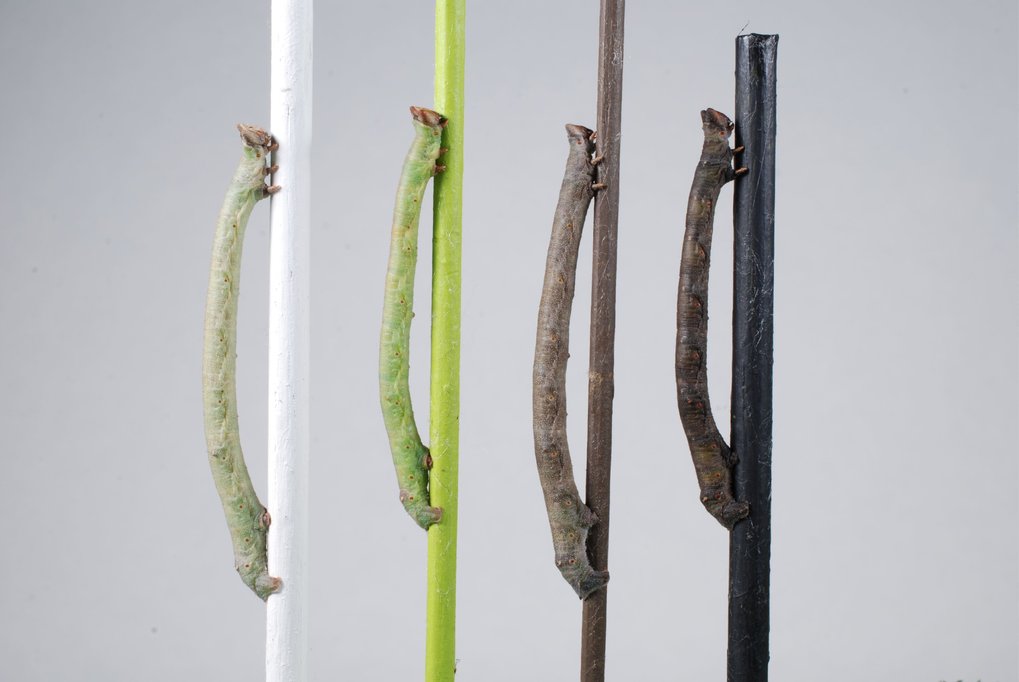Twig-mimicking caterpillars change their colour depending on the background and move to color-matching backgrounds
It is difficult to distinguish caterpillars of the peppered moth from a twig. The caterpillars not only mimic the form but also the colour of a twig. In a new study, researchers of Liverpool University in the UK and the Max Planck Institute for Chemical Ecology in Germany demonstrate that the caterpillars can sense the twig’s colour with their skin. Caterpillars that were blindfolded changed the colour of their bodies to match their background. When given the choice of which background to rest on, the blindfolded caterpillars still moved to the background that they resembled. The researchers also found that genes that are required for vision were expressed not only in the eyes of the caterpillars but also in their also found that genes that are required for vision were expressed not only in the eyes of the caterpillars but also in their skin.

Cephalopods, chameleons and some fish camouflage themselves by adapting their colour to their surroundings. These animals have a system to perceive colour and light independently of the eyes. Some insects, such as caterpillars of the peppered moth (Biston betularia), also match their body colour to the twig color of their food plant; although this colour change is rather slow compared to other animals. Until now, scientists have not known how insect larvae can perceive the colour of their environment and how the colour change occurs. Two theories dating back more than 130 years proposed that the colour change could be caused by the diet or by the animal seeing the color. As some insects are known to be able to perceive light – but not colour – by the skin, researchers from Liverpool University and the Max Planck Institute for Chemical Ecology pursued three different approaches to finally solve the riddle of how caterpillars of the peppered moth match the colour of their surroundings.
First, they tested if caterpillars of the peppered moth, whose eyes were painted over with black acrylic paint, could still adjust their color to the background. The blindfolded caterpillars were raised on white, green, brown and black branches and their body colour observed. Even without being able to see, the caterpillars changed color to resemble the background to the same extent as caterpillars whose eyes were not covered. “It was completely surprising to me that blindfolded caterpillars are still able to pick a branch that best matches their colour. I don’t think my supervisor, Ilik Saccheri, believed me until he saw it by himself”, says Amy Eacock, one of the lead authors of the new study and currently a postdoc at the Max Planck Institute for Chemical Ecology.
Blindfolded caterpillars choose twigs similar to their own colour
In behavioral experiments, blindfolded caterpillars had the choice to move to differently coloured twigs. Consistently the caterpillar rested on the twig most similar to their own colour.
In a third approach, the researchers examined in which parts of the body genes related to vision were expressed. They found them not only in the head of the caterpillars, where the eyes are, but also in the skin of all body segments. One visual gene was expressed even more in the skin than in the heads of the caterpillars. “We assume that this gene is involved in the perception of background color by the skin,” notes Hannah Rowland, second lead author and leader of the .
“One of the major challenges animals face is how to avoid being eaten by predators. Numerous species have evolved camouflage to avoid being detected or recognised. A considerable problem, however, is how prey animals can match the range of visual backgrounds against which they are often seen. Colour change enables animals to match their surroundings and potentially reduce the risk of predation,” says Hannah Rowland, highlighting the study’s ecological context. Amy Eacock adds: “We constructed a computer model that can ‘see’ the same way birds do, so we are able to conclude that these adaptations – colour change, twig-mimicking, behavioral background-matching – likely evolved to avoid visual detection by predators.” Caterpillars with better colour sensing may have been eaten less by birds, while birds with improved vision may prey more upon these larvae, continuing the evolutionary predator-prey arms race.
The study expands our understanding of how lepidopteran larvae protect themselves from predation.








